Horizon Hobby Blade Theory Type W FPV
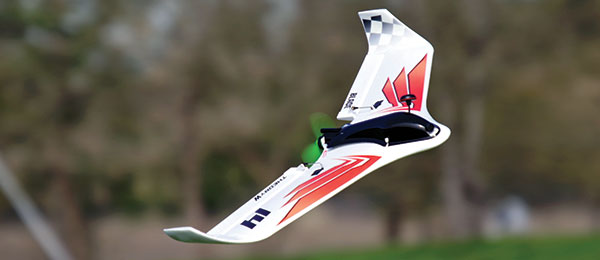
Written by Jon Barnes Wing it with a camera Product review As seen in the June 2017 issue of Model Aviation.
Bonus video
Specifications
Model type: FPV-ready flying wing Skill level: Intermediate Wingspan: 29.9 inches Wing area: 170 square inches Length: 14.2 inches Weight: 16.9 ounces Power system: Brushless electric Radio: Minimum five-channel Spektrum DSM2/DSMX- compatible transmitter required Construction: Z-foam Street price: $299.99Test-Model Details
Motor: Thrust 2205-2350 Kv brushless outrunner (included) Speed controller: Blade 30-amp brushless with 2-amp BEC; XT60 connector (included) Battery: Thrust 35C 4S 14.8-volt 1,300 mAh LiPo FPV camera: Foxeer 600TVL with integrated OSD (included) Video transmitter: Spektrum 5.8 GHz 200 mW (included) Propeller: 5 x 4 two blade Servos: Two Spektrum A3055 submicro digital metal gear Radio system: Spektrum DX9 nine-channel DSMX 2.4 GHz transmitter; Spektrum AR636A six-channel DSMX 2.4 GHz receiver (receiver included) Ready-to-fly weight: 18.4 ounces Flight duration: 6 to 8 minutesPluses
• The only items required to complete this model are a 5.8 GHz-capable ground station or headset; a three- or four-cell 1,300 mAh LiPo battery; and a minimum five-channel Spektrum radio system. • The airframe is designed to accept and easily haul a Möbius or similar form factor HD action camera aloft. • Four large sheets of colorful adhesive-backed graphics allow pilots to create their own unique Theory. • Potentially long flight durations, if a pilot can resist fire-walling the throttle. • Can be broken down and stuffed into a backpack for easy transport and travel.Minus
• The factory location of the video transmitter limits the amount of cooling airflow that it receives. The Blade brand has long been identified as the force behind an impressive variety of electric helicopters and multirotor aircraft. The release of the Blade Theory Type W FPV flying wing marks the company’s first foray into an electric-powered, fixed-wing model. This foam-composition wing is designed to provide pilots easy entry into the exciting world of FPV flying and racing. With a compact 760mm wingspan and wings that can be removed and installed at will because of cleverly designed plastic retention clips, the Theory is designed to be easily transportable. The included Thrust brushless power system can be fed with either a three-cell or four-cell 1,300 mAh LiPo battery, allowing a pilot to effectively configure the Theory for his or her preferred flying style. As with many of its previous product offerings, Blade makes the Theory available in two versions. Completion of the FPV-ready version requires pilots to provide their own video gear, including a camera, video transmitter, and antenna. The FPV-equipped version of the Theory comes with these items preinstalled.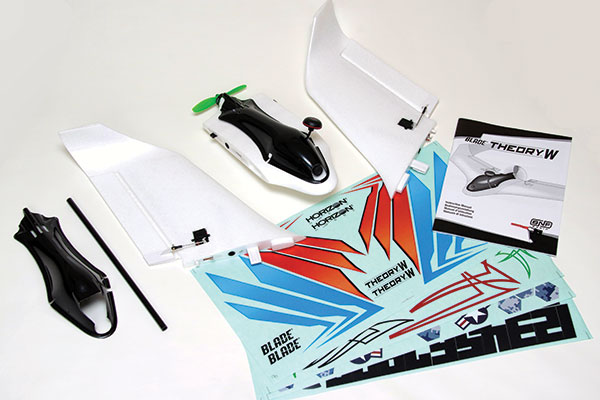
With a full complement of electronics and FPV gear preinstalled, builders ultimately need only focus on creating their own unique racing scheme from the multiple sheets of included colorful graphics.
Both versions require that pilots provide their own 5.8 GHz FPV headset or ground station, as well as a three- or four-cell 1,300 mAh LiPo battery and minimum five-channel Spektrum DSM2/DSMX radio system. This review focuses on the FPV-equipped version of the Theory Type W. The video transmitter included with the FPV-equipped version of the Theory is a Spektrum 200 mW unit. Per the Theory’s online product page and other marketing materials, a Technician license is required to operate the included 200 mW video transmitter in North America (the author of this review possesses an Amateur Extra class license). The included video camera features 600 lines of video resolution and an integrated on-screen display (OSD) that feeds pilots critical telemetry data such as the flight battery voltage and flight duration. Pilots can make a variety of changes to the camera settings using the included mini programming keypad. Additional camera-mounting hardware and accessories are included in a separate box that comes stowed inside the Theory’s box. Both AS3X and SAFE technologies are embedded in the included Spektrum AR636A six-channel 2.4 GHz DSMX receiver. The former acts to minimize the effects of wind and turbulence, while the latter is used to create three different and distinct flight modes. The pilot-friendly Launch Mode, which deflects the elevons slightly upward and severely limits pitch and bank angles, promises to minimize the challenges inherent to hand-launching a flying wing.
Construction
The Theory Type W comes out of its box in three pieces. The included Thrust brushless power system, Spektrum digital metal gear servos, Spektrum (rebranded Foxeer) 600TVL video camera, and 200 mW Spektrum video transmitter/antenna are all factory installed. The video transmitter is positioned below the battery bay, with the antenna protruding upward and outward at a 45° angle. The sole provision made for this radio frequency-energy-generating component to receive vital cooling airflow is a small-diameter hole located forward on the nose of the Theory’s fuselage.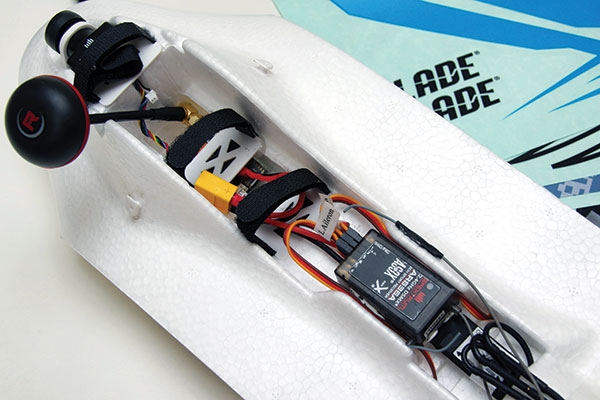
The Spektrum AR636A receiver, 30-amp brushless ESC, 200 mW video transmitter, three- or four-cell 1,300 mAh LiPo battery, and optional action camera are all strategically packed beneath one of the two included removable polycarbonate canopies.
Blade uses slop-free ball link-style connections on the elevon ends of the two pushrods, with a Z-bend used on the servo horn end. Best safety practices dictate that the first assembly step is to remove the propeller. It should not be reattached until after the model is fully assembled and the transmitter completely programmed, including activating the throttle cutoff feature if the transmitter offers this function. When removing the propeller, it’s worth noting that it is not a pusher-style propeller, such as what is often used on a pusher configuration model. Pilots might want to mark one side of the propeller to avoid confusion when reinstalling it. Assembly is as simple as slipping the short carbon-fiber wing spar through the fuselage and mounting the two wing halves. Blade uses plastic retention clips to hold the wing halves in place. The servo connections are keyed to prevent them from being improperly plugged in. Although a fair amount of force is required to properly seat the wing halves and allow the clips to snap into place, the result is that they are held securely in place. With the wing halves in place, pilots can plan and apply their own custom graphics scheme using the nice variety of color graphics that is included and spread across four large sheets. When programming one’s transmitter, pilots must resist the urge to configure the model to use a delta mix. Blade has taken care of the necessary elevon mixing by programming it into the included Spektrum AR636A receiver.
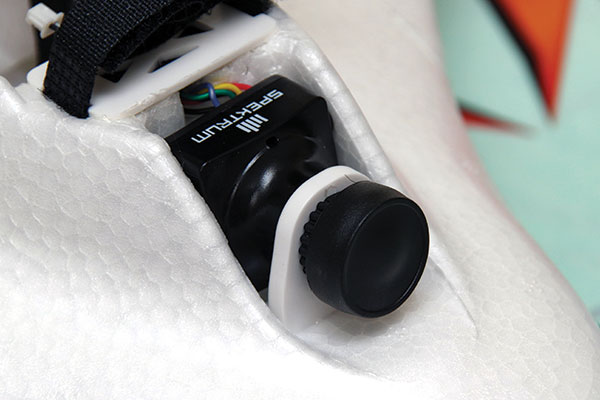
Pilots can optimize the settings of the included Spektrum/Foxeer FPV camera using the included micro-size programming keypad.
Pilots might initially be perplexed to find that the Theory’s ESC comes equipped with an XT-style connector, while the recommended Thrust four-cell 1,300 mAh LiPo battery uses an EC3-style connector. The assembly manual details that these two connectors will actually play nice with one another, effectively eliminating the need to use an adapter or to break out a soldering iron. Blade includes two canopies in the box. One streamlines the included FPV gear, while the other features an additional rectangular cutout that allows a pilot to mount a Möbius (or similar form factor) action camera on a small shelf just above and aft of the FPV camera. Both canopies are polycarbonate in composition and painted black. Pilots will need to remember to remove the clear plastic protective overlay sheets from both canopies before the first flights. Blade makes it easy to verify the proper center of gravity (CG) with the inclusion of a pair of molded-in-the-foam nubs on the underside of the fuselage.
Flying
Every Theory flight will start with a hand launch. Blade includes a properly positioned and correctly shaped grip on the underside of the Theory’s fuselage. Using this launch grip comes with the safety-related caveat of not advancing the throttle until after the model has left one’s hand. A three-finger grip, with one’s thumb and middle finger placed on either side of the grip handle and one’s forefinger placed to the rear of it, enables the person throwing the wing into the air to effectively “push” it forward and into the air. This method gives the model an appropriate amount of forward velocity, until such time as the pilot can advance the throttle and allow the Theory to get up and on step. Blade attaches a reinforcing piece of protective plastic to the aft end of the grip handle, with the apparent design intent being to allow pilots to push the airframe forward without compressing the foam. It is imperative that those who insist on running the throttle up before tossing the Theory into the air use an exaggerated and deliberate follow-through motion. Any failure to do so is almost guaranteed to cause memorable pain. An alternate launch technique successfully used by many pilots—one that keeps all of their digits well away from the rotating propeller—is to grip the leading edge of the wing in their left hand. Advance the throttle and give the model a flat, overhand Frisbee-style toss. This technique also allows a pilot to keep his or her right hand on the all-important aileron/elevator input stick and immediately make any required corrections.
Those who prefer to launch with the power on can do so safely by utilizing an overhand, forward Frisbee-style launch method. The Launch Mode minimizes the number of failed hand launches that pilots can expect to experience.
It feels slightly awkward, especially when it is performed using the left hand, but the AS3X stabilization that is programmed into the Launch Mode has a pilot’s back when using this launch technique. This is especially true when launching the Theory while wearing an FPV headset! Launch Mode biases the elevons upward by a small amount, to encourage a gradual angle of attack on climbout, and actively works to keep the wing level. Pilots will find this one of the best-engineered uses of AS3X stabilization technology to date! The three flight modes and ability of this model to be flown line-of-sight (LOS), FPV, and with or without an action camera installed, give pilots plenty of options and variety! First flights for most will be LOS in order to develop a basic familiarity with the model. After the Theory is in the air, most pilots will probably switch to Intermediate Mode. This mode is perfect for those who prefer to progressively acclimate to the Theory’s in-flight performance. Try to perform loops or rolls in Intermediate Mode, and one will quickly be reminded that roll and pitch angles are restricted in order to prevent overcontrolling. Speeds, when flown on a three-cell battery pack, might be entirely adequate for newer pilots, but those who are more experienced, and with a penchant for going as fast as possible, will probably opt for the extra cell sooner. Using a larger, four-cell battery pack might make it slightly more difficult to achieve the manufacturer’s recommended CG. Performance on four-cell battery packs is impressive and downright ballistic! Switch to Experienced Mode, firewall the throttle, and the Theory will rocket straight upward in virtually unlimited vertical uplines. Roll rates at full speed on four cells are snappy and surprisingly—though not perfectly—axial for a wing. Inverted flight is stable and easily sustained with only a touch of down-elevator required. Slamming the Theory through tight racecourse-style corners, whether upright or inverted, requires extra compensating elevator inputs to prevent the nose from falling through. After the Theory takes the checkered flag, a pilot only needs to line up the wing with the runway, pull the power back, and keep the wing level until touchdown.
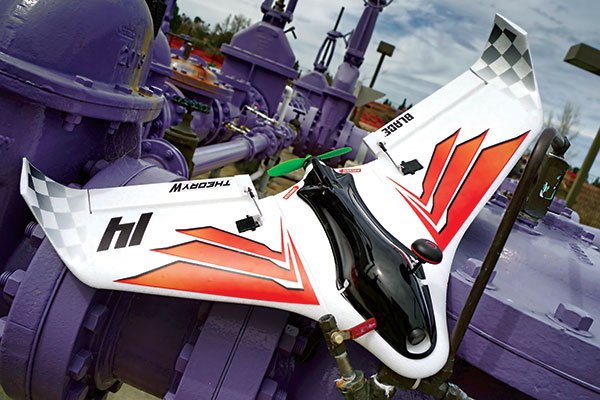
The Blade Theory Type W is a turnkey, high-speed FPV racing solution that is perfect for time-challenged pilots who prefer to spend their limited free time flying instead of vetting out the required video gear and electronics.
Although you might expect that the high-speed performance of the Theory, when flown on four cells, would come at the expense of decreased flight duration, the Thrust outrunner motor efficiently enables flights of 6 to 8 minutes in duration. Pilots interested in capturing their Theory flights on camera can simply belt their Möbius or similar form-factor action camera onto the provided platform and swap to the alternate canopy provided with the Theory. This second canopy features an oversize camera cutout large enough for both the FPV camera and the action camera to peer through, and allows pilots to effectively streamline the airflow around all of the installed camera gear. Blade provides a subtly small cooling air inlet hole for the video transmitter, which is positioned at the very bottom of the fuselage interior. Video transmitters typically produce substantial heat as they generate the radio frequencies necessary to transmit the video signal. Those who fly in hotter environments might find it beneficial to augment the amount of cooling airflow channeled to the video transmitter to prevent it from overheating on longer flights. Another worthwhile tweak to the included camera is to activate its digital wide dynamic range (DWDR) feature, found under the Exposure menu. This feature is disabled by default. Enabling it drastically improves how the camera responds and handles changes to ambient light.










Add new comment